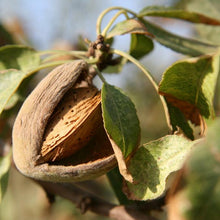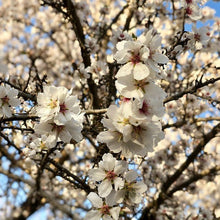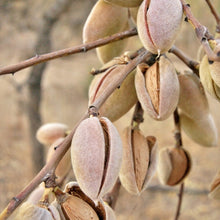|
Mature height x width: |
approx 20' x 20' |
|
Recommended initial spacing: |
5'-10' in rows 22' apart (to thin later) |
|
Recommended final spacing: |
10'-22' x 22' |
| Hardy to: | approx -25°C (-10-15 F) |
|
Preferred soil: |
deep, moist, fertile, well-drained soil |
|
Good for: |
long storage, ornamental, fast-growing, superior flavour |
|
Uses: |
dessert, main dish |
Almonds are a relative of peaches: a fruit with tough flesh and a pit containing a delicious nut. A delicious and versatile nut that can be dried, roasted, sprouted, pressed into oil, or ground into butter. Incredible flowers in spring. Like other stone fruit, they are pollinated by bees and other insects. Life expectancy is around 50 years. These almonds are seedlings from healthy trees on Denman Island and Vancouver Island in the Pacific Northwest.
Planting: Almonds want full sun with light, fertile, well-drained soils. They flower early in the season and buds are susceptible to frost damage, so avoid planting in frost pockets. Tolerant of pH between 5.5 and 8.5 (ideal is between 6.5-8). While almonds are infamous as water-hungry trees in California, they are actually relatively drought-tolerant, though ample water will increase yields.
Why seedlings? Growing seedlings from high-quality parents helps maintain diversity (each seed is a new variety) while drawing on some of the best genetics. In other words, by planting some of these seedlings, you are participating in the breeding new, regionally-adapted varieties! Compared to clonally propagated trees, seedlings tend to have more robust root systems, increased vigour and drought-tolerance.
Why bare root? "Bare root" means that the tree has been grown in the ground (rather than in a pot). In general, bare root trees tend to have larger root systems because their roots aren't constricted by the edges of the pot. Because we don't need to use pots or potting soil, we can sell them more cheaply than potted trees. Bareroot trees must be planted when they are still dormant (Nov - Mar in our region).





